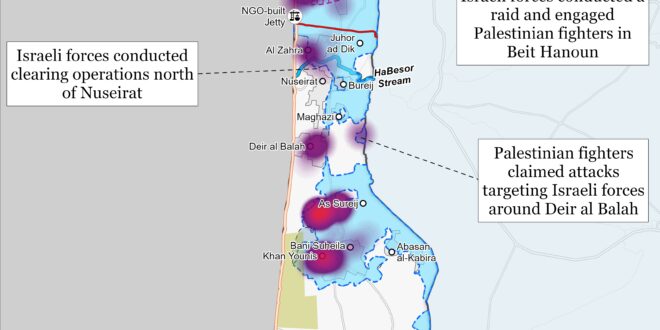Key Takeaways:
- Northern Gaza Strip: The IDF reported that Israeli forces led by the Northern Brigade (Gaza Division) conducted raids targeting Hamas and PIJ sites in Beit Hanoun over the previous week.
- Central Gaza Strip: Israeli forces continued to conduct clearing operations in the central Gaza Strip.
- West Bank: Israeli forces engaged Palestinian fighters in at least three locations across the West Bank.
- Southern Lebanon and Golan Heights: Lebanese Hezbollah conducted at least nine attacks from southern Lebanon into northern Israel, including a complex drone and anti-tank guided missile attack that injured 18 Israelis, including 14 IDF soldiers.
- Iran: A small demonstration occurred outside the Jordanian embassy in Tehran, protesting the Jordanian support in intercepting the recent Iranian drone and missile attack on Israel. CTP-ISW has previously assessed that Iran and its Axis of Resistance have adopted a more confrontational strategy vis-a-vis Jordan in recent months.
- Senior Iranian political and military officials reiterated their threats that Iran would respond “severely” if Israel retaliates for the recent Iranian drone and missile attack on Israel
- Syria: The Wall Street Journal reported that Iran ordered IRGC personnel to evacuate military sites across Syria in anticipation of possible Israeli strikes.
- Iraq: An adviser to the Iraqi prime minister, Subhan al Mullah Jiyad, claimed that the US-Iraqi Higher Military Commission has “set a schedule” for the withdrawal of the US-led international coalition from Iraq.
- Yemen: US CENTOM reported that it destroyed two drones in Houthi-controlled Yemen.
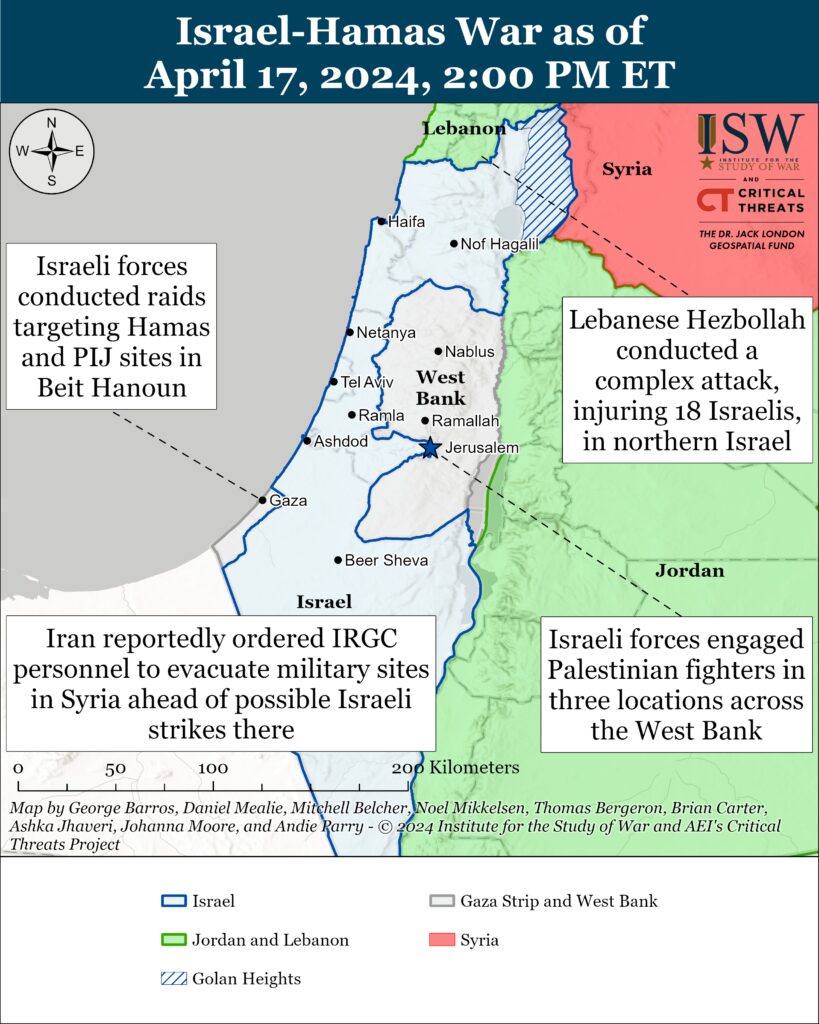
Gaza Strip
Axis of Resistance objectives:
Erode the will of the Israeli political establishment and public to sustain clearing operations in the Gaza Strip
Reestablish Hamas as the governing authority in the Gaza StripThe Israel Defense Forces (IDF) reported on April 17 that Israeli forces led by the Northern Brigade (Gaza Division) conducted raids targeting Hamas and Palestinian Islamic Jihad (PIJ) sites in Beit Hanoun over the previous week.[i] Israeli forces had collected intelligence on the sites from questioning Palestinian fighters, revealing that Hamas and PIJ used a school building for military activity as well as the civilians inside for cover from Israeli targeting. The IDF said that Israeli forces ordered civilians to vacate the building prior to the raid. The IDF detained and killed an unspecified number of Palestinian fighters in the building.
Palestinian militias conducted several attacks targeting Israeli forces in the northern Gaza Strip on April 17. The al Aqsa Martyrs’ Brigades, which is the self-proclaimed military wing of Fatah, claimed that its fighters had conducted 14 mortar and rocket-propelled grenade (RPG) attacks in Beit Hanoun over the previous 24 hours targeting Israeli forces in Beit Hanoun.[ii] A Hamas fighter separately conducted a sniper attack targeting an Israeli soldier in Beit Hanoun.[iii] The National Resistance Brigades lastly mortared Israeli forces in eastern Jabalia.[iv]
Israeli forces continued to conduct clearing operations in the central Gaza Strip on April 17.[v] The 401st and Nahal brigades (162nd Division) are operating near Wadi Gaza to kill Palestinian fighters and destroy military infrastructure. The IDF Air Force struck a Palestinian fighter squad that was using an armed drone in the central Gaza Strip.[vi] The 215th Artillery Brigade and IDF Air Force cooperated to destroy several rocket launchers aimed at Israel.[vii]
The IDF Air Force struck over 40 targets in the Gaza Strip on April 17, including explosively rigged buildings, observation posts, and underground military infrastructure.[viii]
Palestinian sources claimed on April 17 that Israeli forces are operating in eastern Deir al Balah.[ix] Hamas and the al Aqsa Martyrs’ Brigades claimed separate RPG and anti-tank guided missile attacks targeting Israeli forces in the area.[x]
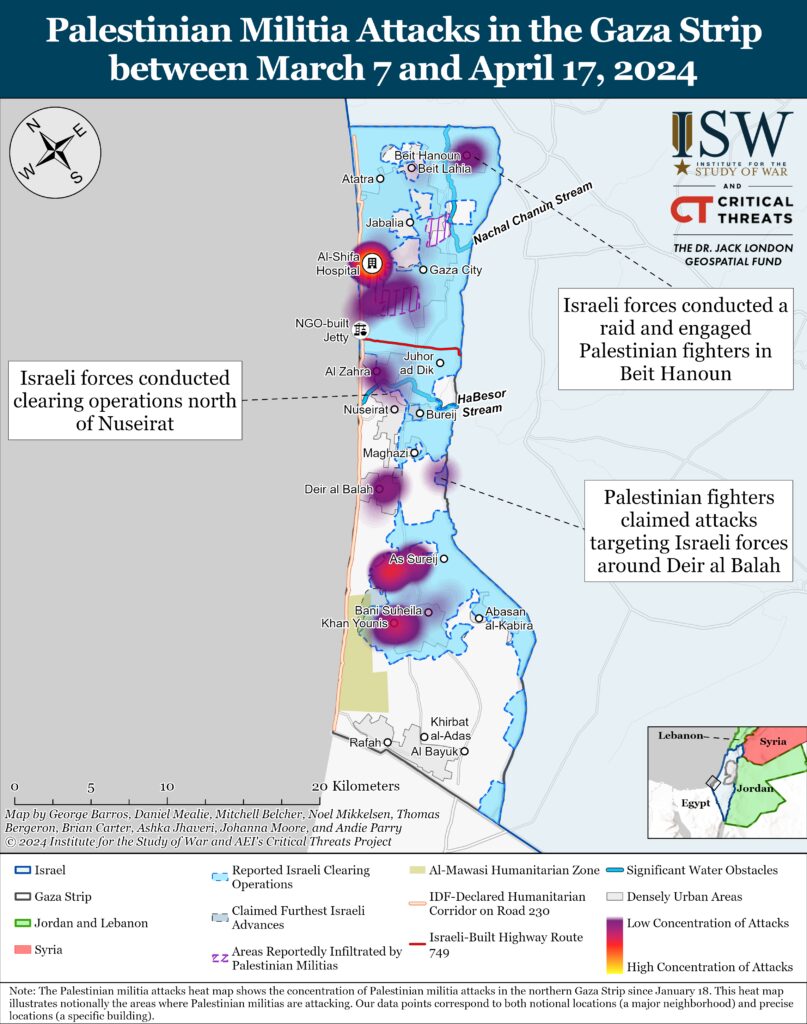
This map displays engagements between Israeli and Palestinian ground forces across the Gaza Strip. The locations depicted are not exact.
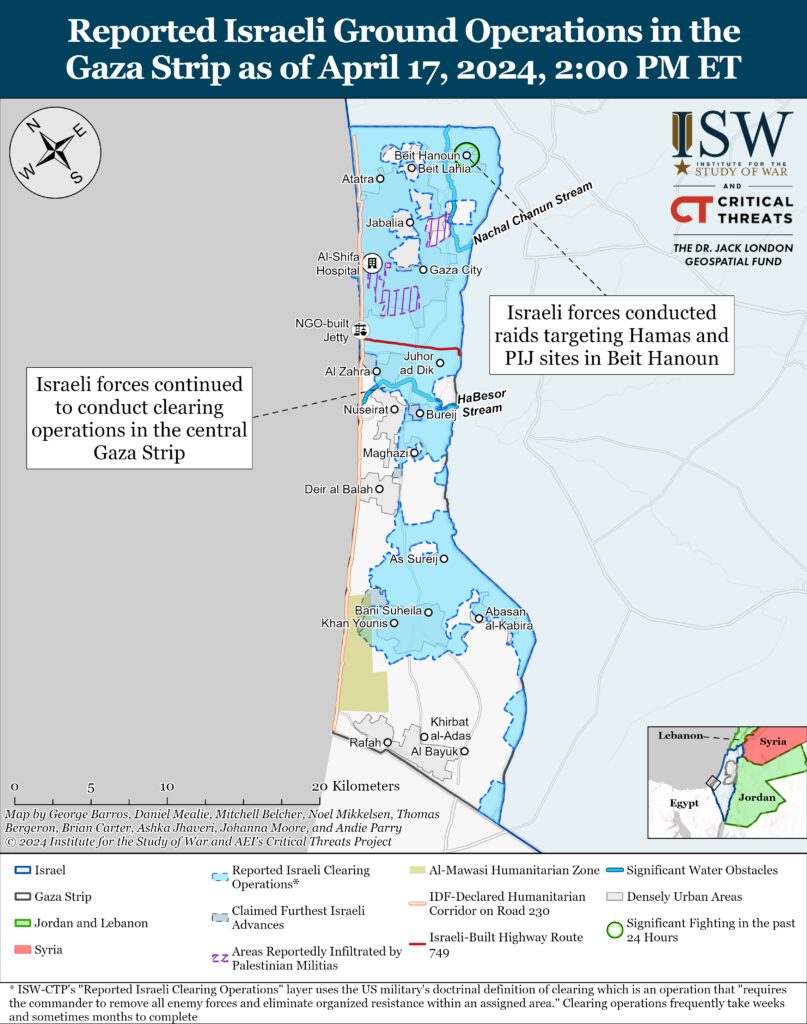
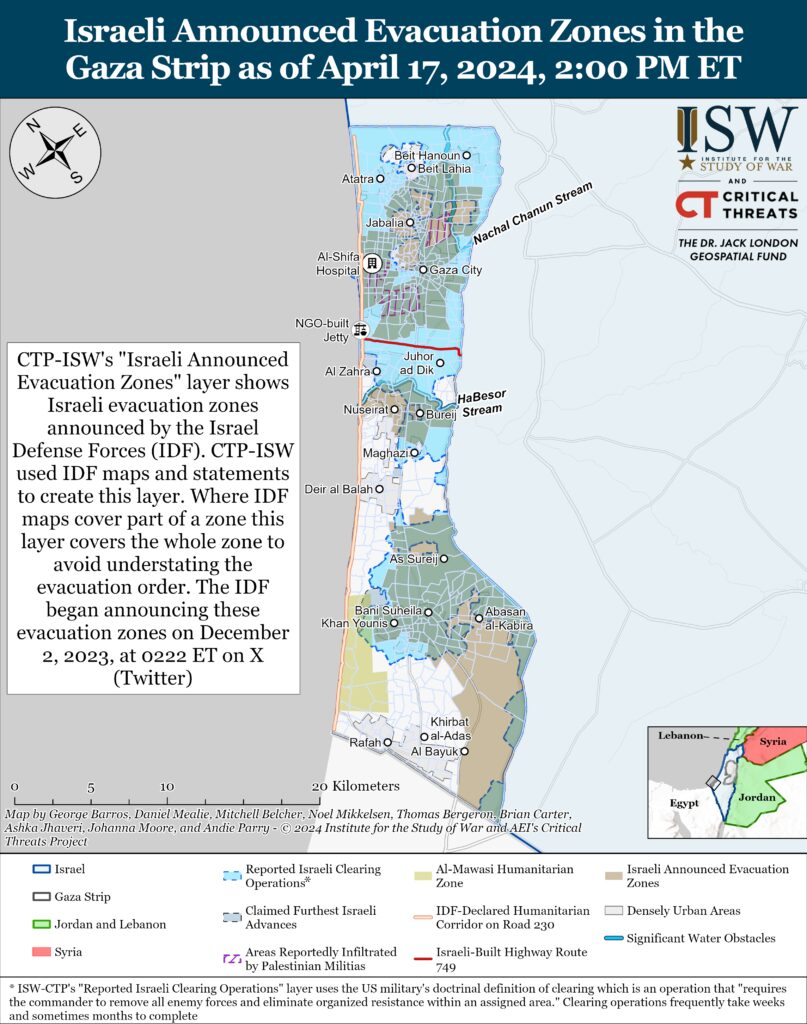
The Coordinator of Government Activities in the Territories (COGAT)—a department within the Israeli Defense Ministry—said that eight aid trucks entered the Gaza Strip from Ashdod Port in southern Israel on April 17.[xi] This instance marks the first time that humanitarian aid has arrived via ship to Israel during the Israel-Hamas war.[xii] The Israeli war cabinet approved the opening of the port on April 5.[xiii] The IDF said that trucks carry aid unloaded from the Ashdod Port into the Gaza Strip through the Kerem Shalom crossing[xiv]
Hamas Political Bureau Chairman Ismail Haniyeh is meeting with senior Turkish officials. Haniyeh met with the Turkish Foreign Affairs Minister Hakan Fidan in Qatar on April 16.[xv] Haniyeh will also meet Turkish President Recep Tayyip Erdogan in Ankara in the coming days.[xvi]
Palestinian fighters fired a single rocket barrage from the Gaza Strip into southern Israel on April 17.[xvii] The Popular Resistance Committees, which is a Palestinian militia aligned with Hamas in the war, targeted an IDF base in Zikim.
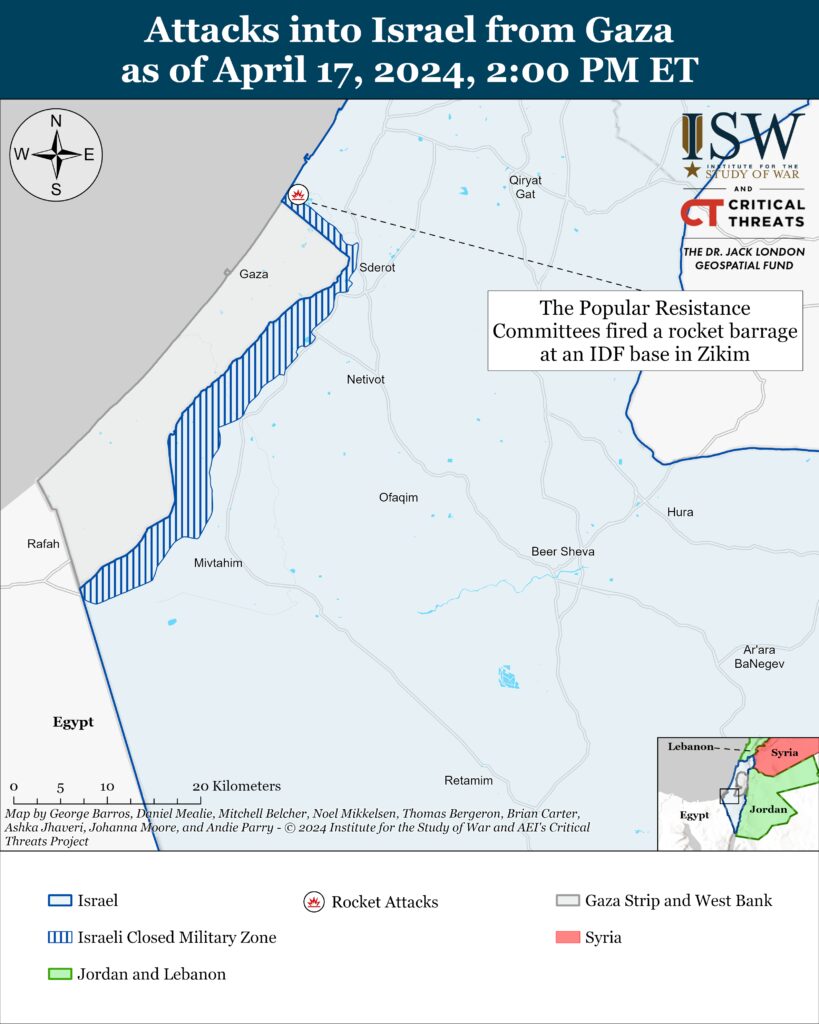
Recorded reports of attacks; CTP-ISW cannot independently verify impact.
West Bank
Axis of Resistance objectives:
Establish the West Bank as a viable front against IsraelIsraeli forces have engaged Palestinian fighters in at least three locations across the West Bank since CTP-ISW’s last data cut off on April 16.[xviii] Three Palestinian militias—PIJ, the al Aqsa Martyrs’ Brigades, and Jundullah—claimed separate attacks targeting Israeli forces around Tubas on April 16.[xix] PIJ also claimed that it detonated an IED targeting an IDF bulldozer.[xx] Jundallah has claimed two previous attacks in Tubas since the Israel-Hamas war began.[xxi]
Israeli forces detained six wanted Palestinians during overnight operations in the West Bank on April 17.[xxii] Israeli police separately detained a Palestinian man in Jerusalem on suspicion of planning to conduct a stabbing attack.[xxiii]
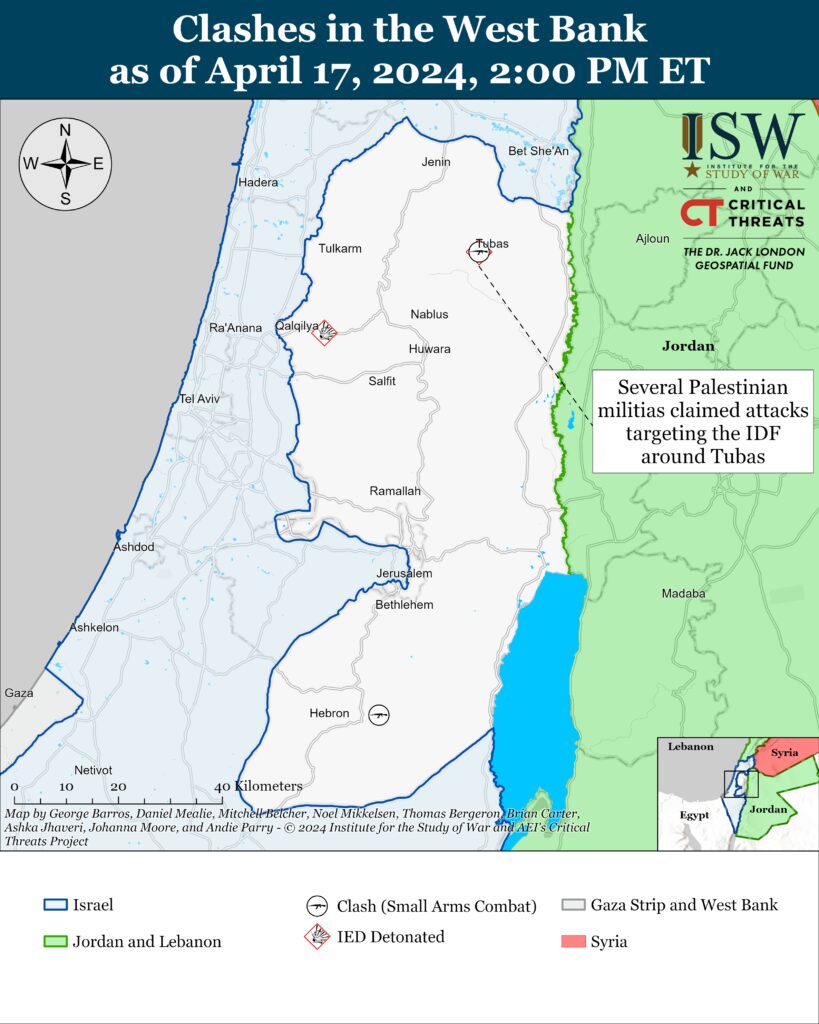
This map is not an exhaustive depiction of clashes and demonstrations in the West Bank.
Southern Lebanon and Golan Heights
Axis of Resistance objectives:
Deter Israel from conducting a ground operation into Lebanon
Prepare for an expanded and protracted conflict with Israel in the near term
Expel the United States from SyriaLebanese Hezbollah conducted at least nine attacks from southern Lebanon into northern Israel on April 17.[xxiv] One of these attacks was a complex drone and anti-tank guided missile attack that injured 18 Israelis, including 14 IDF soldiers, in Arab al Aramsha along the Israel-Lebanon border.[xxv] The drone that Hezbollah used bears visual similarities to an Iranian-made Adabil-2.[xxvi] Hezbollah claimed that it targeted an IDF reconnaissance company headquarters in Arab al Aramsha.[xxvii] The IDF reported that it conducted airstrikes targeting Hezbollah air defense sites near Baalbek in the Bekaa Valley, Lebanon, in retaliation for the Hezbollah drone strike in Arab al Aramsha.[xxviii]
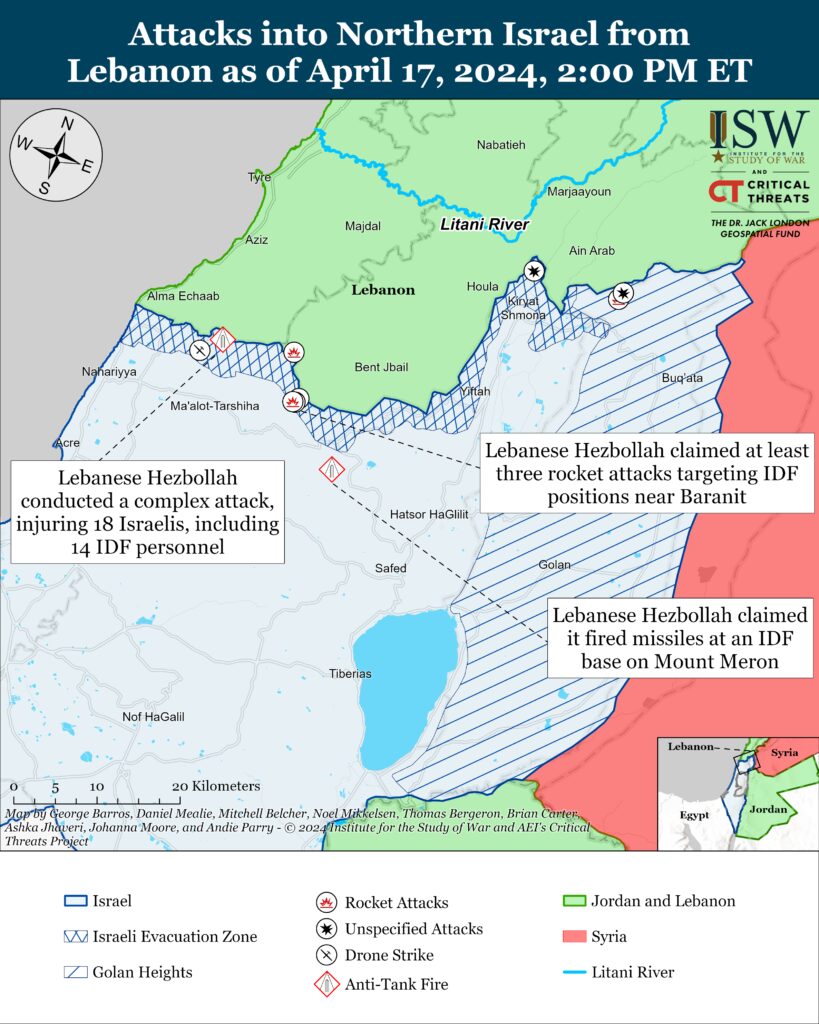
Recorded reports of attacks; CTP-ISW cannot independently verify impact.
Iran and Axis of Resistance
A small demonstration occurred outside the Jordanian embassy in Tehran on April 16, protesting the Jordanian support in intercepting the recent Iranian drone and missile attack on Israel.[xxix] Demonstrators chanted anti-US and anti-Israeli phrases and held posters condemning Jordanian cooperation with the United States and Israel.[xxx] The Jordanian foreign minister said on April 14 that Jordan intercepted the projectiles because it assessed that the Iranian drones and missiles posed a genuine threat to Jordanian national security.[xxxi] IRGC-affiliated media previously threatened Jordan if it further supported Israel.[xxxii]
CTP-ISW has previously assessed that Iran and its Axis of Resistance have adopted a more confrontational strategy vis-a-vis Jordan in recent months.[xxxiii] The Axis of Resistance has indicated its interest in expanding its militia networks into Jordan, which would facilitate the transfer of materiel to the West Bank as well as create possible opportunities to disrupt Israeli overland trade through kingdom.[xxxiv] Iranian and Iranian-backed actors have repeatedly signaled their interest in generating these effects in recent weeks.[xxxv] Iranian-backed Iraqi militia Kataib Hezbollah furthermore criticized Jordanian leaders for supporting the US and Israeli interception of the recent Iranian drone and missile attack on Israel.[xxxvi]
Senior Iranian political and military officials reiterated on April 17 their threats that Iran would respond “severely” if Israel retaliates for the recent Iranian drone and missile attack on Israel.[xxxvii] IRGC Aerospace Force Commander Brig. Gen. Amir Ali Hajji Zadeh, who is primarily responsible for Iranian drone and missile operations, told reporters that Iran would strike Israel again if it responds to the April 13 Iranian attack.[xxxviii] Iranian President Ebrahim Raisi similarly stated that Iran would confront Israel “fiercely and severely” if Israel conducts even the “smallest attack” on Iranian territory.[xxxix] Artesh Commander Maj. Gen. Abdol Rahim Mousavi lastly emphasized that the Iranian armed forces are in a constant state of readiness.[xl]
The Wall Street Journal (WSJ) reported on April 17 that Iran ordered IRGC personnel to evacuate military sites across Syria in anticipation of possible Israeli strikes.[xli] This report follows several local Syrian reports claiming that IRGC leadership issued evacuation orders to Iranian-backed militias in Deir ez Zor Province.[xlii] WSJ reported that Iran also advised Lebanese Hezbollah forces in Syria to take ”precautionary measures” ahead of potential Israeli targeting. Unspecified Syrian security officials told WSJ that Hezbollah accordingly reduced its senior officer presence in Syria and transferred personnel away from military sites. The officials also claimed that Hezbollah recently expanded its force presence along the Israel-Syria border to collect intelligence ahead of possible Israeli strikes.
Iranian-backed Iraqi militia Kataib Hezbollah published a statement criticizing Saudi Arabia on April 17 amid rising tensions between the Axis of Resistance and the kingdom.[xliii] Kataib Hezbollah accused Saudi Arabia of supporting the US agenda in the Middle East. This statement comes as Iranian-backed Iraqi militias have criticized the Gulf states, including Saudi Arabia and the United Arab Emirates, for providing Israel land access to the Persian Gulf.[xliv] It also comes as Saudi Arabia supported the United States and Israel in intercepting the Iranian drone and missile attack on Israel on April 17.[xlv]
An adviser to the Iraqi prime minister, Subhan al Mullah Jiyad, claimed on April 17 that the US-Iraqi Higher Military Commission has “set a schedule” for the withdrawal of the US-led international coalition from Iraq.[xlvi] Jiyad did not provide details about the timeline for a withdrawal. The Higher Military Commission, which is comprised of US and Iraqi military officials, began talks about the status of the US-led international coalition in Iraq in late January 2024.[xlvii] Iranian-backed Iraqi militia and political figures have repeatedly called on Sudani to set a timeline for removing US and international coalition forces from Iraq.[xlviii] Sudani traveled to Washington, DC, on April 15, in part to discuss with US officials ending the US-led international coalition’s mission in Iraq and transitioning to a “comprehensive” bilateral relationship with the United States.[xlix]
US CENTOM reported that it destroyed two drones in Houthi-controlled Yemen on April 16.[l] Houthi-controlled media claimed on April 16 that the United States and United Kingdom conducted two airstrikes targeting unspecified sites in Bajil District, Hudaydah Governorate.[li]
 Eurasia Press & News
Eurasia Press & News
